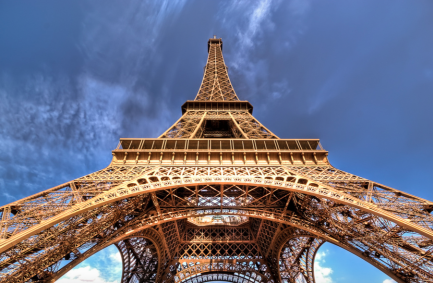Eiffel Tower Ushers in the Modern Era
The wrought iron lattice work tower located at one end of the Parc du Champ de Mars was named for Gustave Eiffel, the engineer whose company designed and built it. Completed in 1889 to serve as the entrance to the World's Fair that would celebrate the centennial of the French Revolution, it is the tallest structure in Paris, at 1,063 ft., and is the most-visited monument in the world.
The initial design of the Eiffel Tower was the work of Maurice Koechlin and Émile Nouguier, two senior engineers working for the Compagnie des Établissements Eiffel. Koechlin describes his sketch as, "…a great pylon, consisting of four lattice girders standing apart at the base and coming together at the top, joined together by metal trusses at regular intervals.”
There are three levels for visitors, and the Eiffel Tower has restaurants on the first and second levels. Eiffel consulted Stephen Sauvestre, the head of the company's architectural department, who contributed the decorative arches to the base and a glass pavilion to the first level. Attempting to gain approval of his plan from the Société des Ingénieurs Civils, Eiffel stated the tower would symbolize, "Not only the art of the modern engineer, but also the century of Industry and Science in which we are living, and for which the way was prepared by the great scientific movement of the eighteenth century and by the Revolution of 1789, to which this monument will be built as an expression of France's gratitude."
The Eiffel Tower joined the list of now beloved artworks that were at first reviled, including Beethoven’s 9th, Stravinsky’s Rite of Spring, Moby Dick, and the Guggenheim, and stellar figures in the arts, such as Guy de Maupassant, Adolphe Bouguereau, Charles Gounod, and Jules Massenet signed a petition called Artists Against the Eiffel Tower after having only seen the drawings. They wrote,, “We, writers, painters, sculptors, architects and passionate devotees of the hitherto untouched beauty of Paris, protest with all our strength, with all our indignation in the name of slighted French taste, against the erection ... of this useless and monstrous Eiffel Tower... a giddy, ridiculous tower dominating Paris like a gigantic black smokestack, crushing under its barbaric bulk Notre Dame, the Tour Saint-Jacques, the Louvre, the Dome of les Invalides, the Arc de Triomphe, all of our humiliated monuments will disappear in this ghastly dream…” and they go on. Too late - approval had been given and work had started.
Begun in January of 1887, the foundations for each of the four legs consisted of 6.6 ft. concrete slabs, each slab supporting a block of limestone with an attached shoe, to then hold the ironwork. Made of puddled iron - a very pure structural iron that is extremely light for its size and ability to withstand high winds, swaying notably. Innovative engineering and production methods allowed a fairly small team to achieve what is now considered an astonishing piece of structural art. Eiffel made use of advanced knowledge of the dynamics of the metal arch and truss, including load and wind forces. His company was expert at bridge engineering and this influenced his aesthetic and construction techniques. Draftsmen produced thousands of precise drawings needed for the complex angles, and sub-assembles were riveted together in an off-site factory, and returned there for adjustment if they did not fit precisely.
After its completion the tower gained praise, recognized as an engineering and artistic triumph, and WWI solidified it as the symbol of Paris, although writer Guy du Maupassant is said to have eaten in its restaurant every day because it was the only place in the city where one could enjoy a meal without having to look at it. The Eiffel Tower, strong and indomitable, yet elegant and beautiful, like the city itself. Vive la France.
Image 1: Alberto Garcia, Image 3: hjjanisch.




